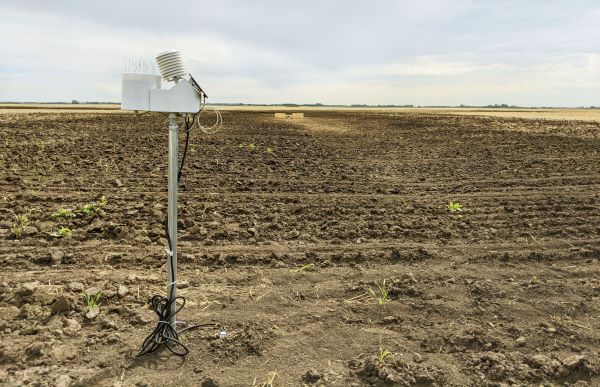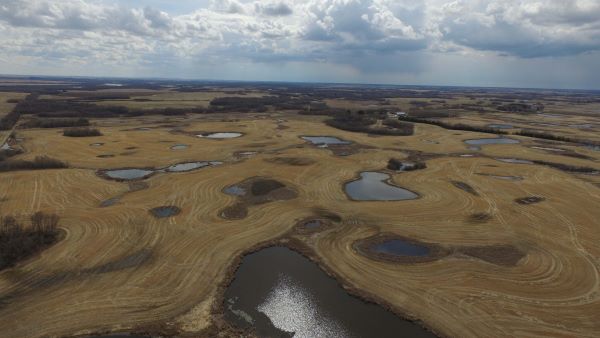Water Security Agency – Agricultural water management projects can be an effective tool to increase farm efficiency and productivity, especially when producers are able to follow evidence-based research. That is why several agricultural industry groups are partnering to advance three agricultural water management research projects beginning this year.
More than $350,000 has been awarded to investigate projects focused on innovative drainage techniques, including tile drainage, and opportunities to enhance soil health, wetland carbon storage, and water quality – with $263,342 provided through the Agriculture Development Fund (ADF) and the remainder from industry stakeholders. This is part of the $9.1 million ADF jointly announced in January 2022 by the federal and provincial governments, and an additional $4.1 million from various industry partners, which supports 55 new crop-related research projects.
The Saskatchewan Wheat Development Commission (SaskWheat), Saskatchewan Conservation and Development Association (SCDA) and the Saskatchewan Canola Development Commission (SaskCanola) are funding and supporting the agricultural water management projects, with partnership from the Water Security Agency (WSA).
These projects are important to the work we are doing as part of the Agricultural Water Management Strategy,” Acting WSA President and CEO Shawn Jaques said. “These partnerships will offer important front-line knowledge that will feed into our developing mitigation policy and provide the tools and tangible benefits that will strengthen farm and ranch operations for years to come.”
Tile Drainage Research
One of those projects will investigate agricultural drainage methods using tile drainage in Saskatchewan.
Conservation Learning Centre (CLC) researchers near Prince Albert are working to identify the most appropriate way to drain scattered depressions/wetlands by comparing four different methods: surface/ditching, tile drainage, a combination of tile and ditching, and a single buried pipe.
“We want to know which method is best at removing excess water, improving nutrient availability, increasing yields, and dealing with salinity,” Conservation Learning Centre Manager Robin Lokken said. “We also plan to determine what method is most cost effective.”
Drainage will be installed at the CLC Agriculture-Applied Research Management site by fall 2022.
CLC is a producer led demonstration farm on the northern edge of the Prairie Pothole Region, south of Prince Albert. They will be installing wells to monitor water levels and collecting soil, plant and yield data over the next four years. Salinity mapping will also be completed at the start and end of the project.
This project is the result of many producers inquiring about how well drainage tile works.
“Elsewhere in the world, tile drainage is widely adopted as a successful management strategy to reduce excess water and alleviate yield losses, but it has not been thoroughly investigated for its effectiveness in Saskatchewan,” Lokken adds. “While surface drainage has been the cheaper, easier alternative – interest in tile drainage is growing. Producers need information on the agronomics as well as the cost-benefits.”
Farmers typically use tile drain systems to lower the water table below the root zone of the crop, helping avoid negative impacts on the plants due to saturated soils – thus increasing yields.
The SCDA is contributing $10,000 towards the project.
“SCDA sees tile drainage as an innovative alternative to traditional ditching,” SCDA Executive Director Crandall Hrynkiw said. “There are several ways that tile drainage can be used, and it is important to demonstrate these applications so farmers can have an example to demonstrate its effectiveness. We hope this research will demonstrate tile drainage as a viable solution to effectively increase the production capacity of grains in our province.”
The project is expected to be completed by 2025.

Variable Rate Fertility Management Research
The second project, led by Glacier FarmMedia Discovery Farm Langham, is investigating ways that variable rate fertility management can protect water quality.
Discovery Farm works with agricultural partners on demonstration research initiatives to show how products or equipment will have a positive impact on the industry through in-field trials and demonstrations. As part of this project, eight mini watersheds (constructed in fall 2020) will compare variable rate fertilizer application, residue management and cover crop cocktails. Each is equipped to measure the amount of water that will come off the watershed and test water quality.
Researchers will study this project for four field seasons (2022-2025) – assessing the impact that 4R Nutrient Stewardship practices have on crop yields and nutrient uptake, as well as nitrogen and phosphorus losses in run-off water.
The 4Rs approach incorporates the:
- Right fertilizer source at the
- Right rate, at the
- Right time and in the
- Right place
SaskWheat and SaskCanola are contributing a combined $216,200 towards this project.
“Variable rate fertility has the dual benefit of allowing farmers to apply fertilizers to areas of a field that can benefit the most from fertilizer application, while reducing fertilizer rates in areas that won’t provide a yield benefit for the cost,” says SaskCanola Research Manager Doug Heath. “SaskCanola’s research investment in 4R fertilizer management practices shows leadership and a willingness for continuous improvement both to help farmers reduce input costs in Saskatchewan but also to mitigate environmental issues of fertilizer losses”
Discovery Farm echoes Heath’s comments, anticipating this research will give farmers a balanced approach to how they manage their water.
“Discovery Farm supports the Water Security Agency in fulfilling the Agricultural Water Management Strategy,” Weiseth adds. “This project will help farmers manage water within the landscape while limiting potential adverse environmental impacts.”
The Agricultural Water Management Strategy was introduced in 2016 with a goal to create responsibly managed and sustainable agricultural drainage networks focused on controlling and organizing water within each local watershed.
Wetland Carbon Storage Research
Finally, WSA is partnering with the University of Saskatchewan (USask) over the next two years to study current wetland carbon storage values and the potential impacts related to agricultural drainage. The project is looking at soil carbon storage in intact and drained wetlands in the Prairie Pothole Region of Saskatchewan, while considering how consolidated wetlands contributes to soil carbon storage.
“We are interested in this project as it will support the development of management strategies that will improve the sustainability of our agricultural systems,” USask Soil Science PhD candidate Chantel Chizen said.
This study will collect soil samples from drained wetlands at Discovery Farm and across the Dark Brown and Black soil zones in Saskatchewan to measure soil carbon. They will also be sampling intact wetlands more broadly.
“Knowing the amount of soil carbon stored in wetlands will play a key role in developing best management practices for wetland management and environmental carbon management in agricultural landscapes,” Chizen adds.
Soil carbon in wetlands tend to have higher plant productivity and periods of water saturation that allow for greater organic matter accumulation compared to upland areas. Soil organic matter is an important property that contributes to soil health through nutrient availability, water retention, soil structure, and erosion prevention.









